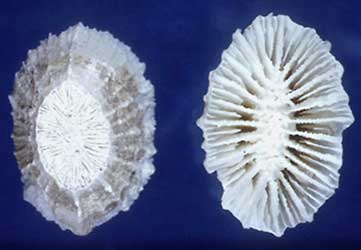Flabelloidea
Stephen D. CairnsIntroduction
Representatives of this superfamily occur from the Late Jurassic (135 million years ago) to the Recent, and are widespread in the world oceans and commonly found as fossils on all continents, including Antarctica. All known species are azooxanthellate, and occur at depths of 0-3200 meters. Most species are inconspicuous by virtue of small size (as small as 1 mm calicular diameter) or cryptic and/or deep habitat. Approximately 110 living species in 18 genera have been described (Cairns et al., 1999), and about twice that number of fossil species. All flabelloideans are solitary in growth form; some of them asexually reproduce by transverse division and various forms of budding. Although inconspicuous, some occur in large numbers in certain environments.
Characteristics
The superfamily is characterized by having coralla with a marginothecate wall, as opposed to a septothecal or parathecal wall of the superfamily Caryophyllioidea, or the epithecal wall of the Volzeioidea. Structurally, the marginotheca (Stolarski, 1995) is a primitive, neotenic wall consisting of vertically arranged minitrabeculae that are manufactured from the edge zone of the coral. Additional smooth, non-trabecular calcium carbonate deposits called textura (Stolarski, 1995), literally "plaster" in Latin, are often secreted on the outside of the corallum by the edge zone, and occasionally nontrabecular calcium carbonate is also deposited within the corallum in a structure called stereome. The wall of flabelloids is not epithecate, as previously thought (see Stolarski, 1995), since it consists of trabeculae (epitheca is nontrabecular) and originates from the edge zone (epitheca originates from a lappet cavity). Marginotheca is usually quite smooth, often porcellaneous, but may exhibit low circumferential growth ridges.
Discussion of Phylogenetic Relationships
No phylogenetic analysis has been performed on the suprageneric taxa of the Caryophylliina. Chevalier (1987) did not acknowledge superfamilies within the suborder Caryophylliina. Most recently, Stolarski (1995, 2000) has examined the wall microstructure of many of the flabelloid genera, which led to a redefinition of some wall terminology and will ultimately lead to the redistribution of some of the genera and even families within this suborder.
References
Cairns S. D., B. W. Hoeksema, and J. van der Land. 1999. Appendix: List of Extant Stony Corals. Atoll Research Bulletin, 459: 13-46.
Cairns S. D. and S. A. Parker. 1992. Review of the Recent Scleractinia (Stony Corals) of South Australia, Victoria and Tasmania. Records of the South Australian Museum, Monograph Series, 3: 82 pp.
Chevalier, J.-P. 1987. Ordre des Scléractiniares: Systématique. Pp. 679-753 In: Grassé, P. (editor) Traité de Zoologie, 3(3) Masson, Paris.
Stolarski, J. 1995. Ontogenetic development of the thecal structures in caryophylliine scleractinian corals. Acta Palaeontologica Polonica, 40: 19-44.
Stolarski, J. 2000. Origin and phylogeny of Guyniidae (Scleractinia) in the light of microstructural data. Lethaia, 33: 13-38.
Vaughan, T. W. and J. W. Wells. 1943. Revision of the suborders, families, and genera of the Scleractinia. Geological Society of America, Special Papers, 44: 363 pp.
Wells, J. W. 1956. Scleractinia. Pp. F328-F444 In: Moore, R. C. (editor) Treatise on Invertebrate Paleontology, Part F: Coelenterata. University of Kansas Press, Lawrence.
Title Illustrations

| Scientific Name | Truncatoflabellum truncum |
|---|---|
| Location | off Chile (depth 1500 m) |
| Specimen Condition | Dead Specimen |
| Body Part | skeleton, the basal view shows the detachment scar from asexual transverse division |
| View | Calicular and basal views |
| Size | Greater calicular diameter 30 mm |
| Image Use |
 This media file is licensed under the Creative Commons Attribution-NonCommercial License - Version 3.0. This media file is licensed under the Creative Commons Attribution-NonCommercial License - Version 3.0.
|
| Copyright |
© 2002

|
About This Page
Creation of this page was supported by US National Science Foundation grants DEB95-21819 and DEB 99-78106 (in the program PEET - Partnerships to Enhance Expertise in Taxonomy) to Daphne G. Fautin, grant DEB99-78086 (in the program PEET) to Stephen D. Cairns, and grant OCE 00-03970 (in NOPP, the National Oceanographic Partnership Program) to D.G.F. and Robert W. Buddemeier.Technical assistance was rendered by Adorian Ardelean.

Smithsonian Institution, Washington, D. C., USA
Correspondence regarding this page should be directed to Stephen D. Cairns at
Page copyright © 2002
 Page: Tree of Life
Flabelloidea .
Authored by
Stephen D. Cairns.
The TEXT of this page is licensed under the
Creative Commons Attribution-NonCommercial License - Version 3.0. Note that images and other media
featured on this page are each governed by their own license, and they may or may not be available
for reuse. Click on an image or a media link to access the media data window, which provides the
relevant licensing information. For the general terms and conditions of ToL material reuse and
redistribution, please see the Tree of Life Copyright
Policies.
Page: Tree of Life
Flabelloidea .
Authored by
Stephen D. Cairns.
The TEXT of this page is licensed under the
Creative Commons Attribution-NonCommercial License - Version 3.0. Note that images and other media
featured on this page are each governed by their own license, and they may or may not be available
for reuse. Click on an image or a media link to access the media data window, which provides the
relevant licensing information. For the general terms and conditions of ToL material reuse and
redistribution, please see the Tree of Life Copyright
Policies.
- First online 28 October 2002
Citing this page:
Cairns, Stephen D. 2002. Flabelloidea . Version 28 October 2002. http://tolweb.org/Flabelloidea/19020/2002.10.28 in The Tree of Life Web Project, http://tolweb.org/









 Go to quick links
Go to quick search
Go to navigation for this section of the ToL site
Go to detailed links for the ToL site
Go to quick links
Go to quick search
Go to navigation for this section of the ToL site
Go to detailed links for the ToL site